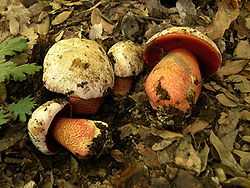Boletus rhodoxanthus
| Boletus rhodoxanthus | |
|---|---|
 | |
| Scientific classification | |
| Kingdom: | Fungi |
| Division: | Basidiomycota |
| Class: | Agaricomycetes |
| Subclass: | Hymenomycetes |
| Order: | Boletales |
| Family: | Boletaceae |
| Genus: | Boletus |
| Species: | B. rhodoxanthus |
| Binomial name | |
| Boletus rhodoxanthus (Krombh.) Kallenb. (1925) | |
| Boletus rhodoxanthus | |
|---|---|
|
| |
| pores on hymenium | |
| cap is convex | |
| stipe is bare | |
| spore print is olive-brown | |
| ecology is mycorrhizal | |
| edibility: poisonous | |
Boletus rhodoxanthus is a fungus of the genus Boletus. It is a rare, inedible bolete found in warm deciduous forests of southern Europe mainly under oak and beech, on chalky soil.
Description
B. rhodoxanthus produces a large, colourful fruit body. The cap is convex, coloured mostly whitish-grey, and flushed with pink especially towards the margin. The cap expands with maturity and may exceed 20 cm in diameter. The tubes are initially yellow in immature specimens, soon becoming bright red, and stain blue when damaged.
The stem is bulbous when young, but becomes more slender with maturity. It bears a dense carmine network covering an orange-yellow background. The flesh is bright yellow, turning blue when cut but only in the cap and not in the stem base. It has a mild taste.
The spores are olive-brown in colour, ellipsoid to fusiform, sized 10–15 by 4–5.5 μm.
Edibility
B. rhodoxanthus is poisonous and unsuitable for consumption, although its toxicity varies significantly from region to region depending on the substrate.
Similar species
- Boletus legaliae grows with oak, and has a distinctive smell of chicory. Its cap is initially grey and then later flushes carmine from the rim.
- Boletus rhodopurpureus grows in mixed woodland, and also bears red-coloured pores and stem. It has a reddish cap with pink or crimson overtones, and flesh that stains deep blue throughout.
- Boletus satanas grows in a similar habitat, and shares many features with B. rhodoxanthus including a whitish cap. However, its cap lacks flushes of pink, its flesh is whitish and turns pale blue all over when the fungus is sectioned.
See also
| Wikimedia Commons has media related to Boletus rhodoxanthus. |
References
- E. Garnweidner. Mushrooms and Toadstools of Britain and Europe. Collins. 1994.
- M. B. Ellis, J. P. Ellis Fungi without gills (hymenomycetes and gasteromycetes): an identification handbook. Springer. 1990.